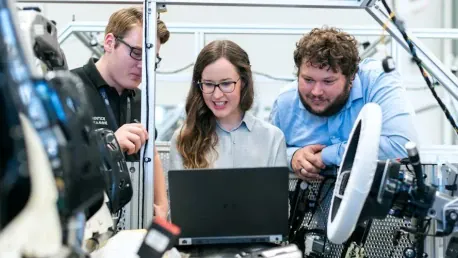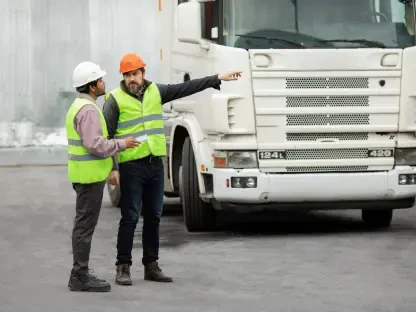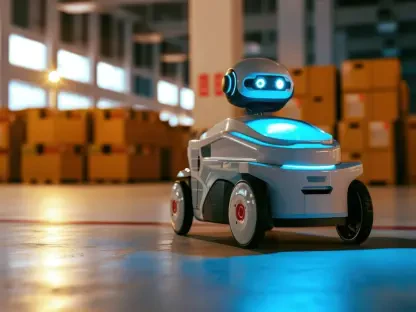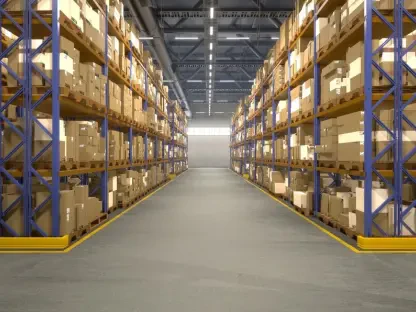The automotive manufacturing industry is undergoing a significant transformation with the integration of humanoid robots. These advanced robots are revolutionizing production lines by enhancing efficiency, flexibility, and operational safety. The following paragraphs delve into the specific implementations and technological advancements driving this change.
Enhanced Dexterity and Flexibility
Overcoming Traditional Limitations
Humanoid robots have introduced a new era of manufacturing prowess by overcoming the limitations of traditional robotic systems. Unlike their predecessors, these advanced robots exhibit a high degree of dexterity and flexibility, performing repetitive and labor-intensive tasks along production lines and in warehouse settings. By adopting this technology, automotive companies can surmount labor shortages that have long plagued the industry while also boosting overall efficiency. These humanoid robots perform tasks previously thought to be too intricate for mechanized systems, thus opening numerous avenues for streamlining operations and reducing dependency on human labor for basic, repetitive functions.
The significance of these robots extends beyond their mechanical abilities; their presence in the manufacturing sector also represents a strategic advantage in workforce management. Instead of relying solely on human workers for repetitive tasks, companies can reallocate human resources to more complex and value-added activities. This shift not only maximizes productivity but also fosters a more innovative work environment by reducing the monotony of routine tasks. Consequently, the integration of humanoid robots is not merely a technological upgrade—it is a comprehensive enhancement of the manufacturing ecosystem, aligning operational goals with workforce optimization.
Advanced Technologies Integration
The incorporation of artificial intelligence (AI), machine learning, and digital twin technology into humanoid robots has significantly elevated their operational efficiency. Advanced technologies enable these robots to adapt seamlessly to complex environments specifically designed for human operators. For instance, AI allows robots to learn and evolve through continuous data analysis and pattern recognition, enabling them to perform tasks with increasing accuracy and efficiency. Machine learning enhances this capability by enabling robots to improve their performance over time, based on historical data and real-time feedback.
Digital twin technology further augments the capabilities of humanoid robots. By creating a virtual replica of the physical manufacturing environment, robots can simulate different operations and optimize tasks without disrupting ongoing processes. This technology provides a detailed preview of how robots will interact with machinery, tools, and human workers, thus minimizing potential errors and enhancing overall productivity. Through this triad of advanced technologies, humanoid robots are not just filling gaps but are actively transforming complex manufacturing ecosystems into highly efficient, adaptable, and resilient operations.
Audi’s High-Tech Production Plant
Partnership with FAW
Audi’s collaboration with the Chinese company FAW in their Changchun production plant stands as a testament to how far technological innovation can be pushed in automotive manufacturing. The partnership is geared towards creating a sophisticated production environment marked by high levels of automation and digitalization. At the heart of this innovative setup is a fully automated system that seamlessly integrates various facets of the manufacturing process, from assembly line tasks to maintenance. The streamlined operations are managed by a unified IT architecture that ensures all subsystems work in harmony, mitigating delays and enhancing efficiency.
The Changchun plant leverages cutting-edge visual recognition technology to maintain stringent quality control standards. High-resolution cameras and sensors constantly monitor every step of the production process, ensuring that each component meets the company’s rigorous criteria. Additionally, the facility employs a fully automated storage and retrieval system that optimizes inventory management, reducing downtime and ensuring the timely delivery of materials. This high-tech infrastructure exemplifies Audi’s commitment to integrating advanced technologies into their production lines, thereby setting a benchmark for the automotive industry.
Sustainability and Efficiency
Audi’s flagship Changchun plant not only focuses on high-tech automation but also emphasizes sustainability and efficient production methods. The plant’s digitally connected processes are designed to minimize waste, optimize energy use, and reduce the overall carbon footprint. For example, real-time data analytics are employed to monitor energy consumption and identify opportunities for efficiency improvements. By integrating these insights into daily operations, Audi ensures that the production process is both environmentally responsible and cost-effective.
The focus on sustainability extends to the materials and resources used in the production process. Recyclable materials are prioritized, and waste management systems are in place to ensure that any by-products are disposed of responsibly. Audi’s commitment to sustainable practices is evident in every aspect of the Changchun plant, from the sourcing of raw materials to the final assembly of vehicles. By marrying advanced technology with sustainable practices, Audi demonstrates that efficiency and environmental responsibility can go hand-in-hand, setting a new standard for the automotive industry.
Process Acceleration and Humanoid Collaboration
Beijing Innovation Center Collaboration
Audi has taken significant strides towards integrating humanoid technology into their operations through a collaboration with the Beijing Innovation Center of Humanoid Robotics and UBtech Robotics. This partnership aims to harness the power of digitalization and automation to achieve high-level efficiency and speed in manufacturing processes. The synergy between skilled workers and advanced humanoid robots is at the core of this initiative, allowing for complex tasks to be executed with unprecedented precision and speed. This collaborative approach ensures that human expertise is complemented, rather than replaced, by technological advancements.
The use of humanoid robots in this collaborative framework significantly accelerates various manufacturing processes. For example, robots can handle physically demanding tasks such as lifting and transporting components, freeing human workers to focus on more intricate and value-added activities. This not only speeds up the production process but also enhances the overall quality of the output. The integration of humanoid robots in Audi’s operations represents a balanced approach to automation, where technology and human skills coexist to drive operational excellence.
Testing and Integration
Ensuring seamless functionality and compatibility is crucial for the successful deployment of any software system. Comprehensive testing and thorough integration processes help identify and resolve potential issues before they become problematic. Integrating different components effectively ensures that all parts work together harmoniously, providing a reliable and effective solution.
To stay competitive in the rapidly evolving Battery Electric Vehicle (BEV) landscape, Audi continually tests a range of innovative technologies, integrating new solutions into their production workflows. This proactive approach ensures that Audi remains at the forefront of technological advancements, adapting quickly to changes in the industry. Through rigorous testing and evaluation, Audi identifies the most effective technologies and processes, seamlessly incorporating them into their manufacturing operations. This ensures that the company is always leveraging the latest advancements to enhance efficiency and productivity.
The integration of new technologies is conducted with meticulous attention to detail. Audi meticulously maps out processes and logistics patterns to ensure that new solutions can be implemented without disrupting existing workflows. This methodical approach minimizes potential risks and facilitates a smooth transition to advanced manufacturing techniques. By continuously refining their operations and embracing technological innovation, Audi demonstrates a commitment to maintaining their competitive edge in the dynamic automotive industry.
Nio’s Deployment of Walker S Robots
Assembly Line Tasks
Nio has embraced the future of automotive manufacturing by deploying the Walker S humanoid robot from UBtech Robotics to perform various assembly line tasks. These tasks include quality inspections and the affixing of vehicle logos, which are critical for ensuring the final product meets the company’s high standards. The Walker S robots contribute to a more efficient production process by performing these tasks with precision and consistency, reducing the likelihood of errors that can occur with human labor. This deployment marks a significant step towards a more automated and streamlined assembly line.
However, the integration of these robots is not without its challenges. Ongoing tests reveal that the Walker S robots require extensive training to reach their optimal performance levels. This training period involves not just calibrating the robots to perform specific tasks, but also programming them to adapt to various scenarios that may arise on the assembly line. Despite these challenges, Nio remains committed to leveraging humanoid robots to enhance their manufacturing capabilities. The potential benefits in terms of increased efficiency and reduced labor costs make this investment worthwhile, paving the way for a more automated future.
Developmental Curve
The extensive training required for the Walker S robots to reach optimal performance levels highlights the developmental curve still present with current humanoid technology. This curve represents the ongoing efforts to refine and enhance the capabilities of humanoid robots, ensuring they can perform tasks with the highest level of accuracy and efficiency. The challenges encountered during this developmental phase are part of the natural progression toward perfecting the technology, and they provide valuable insights that drive further innovation.
Despite the developmental curve, the potential for increased efficiency and reduced labor costs makes the investment in humanoid robots a strategic move for Nio. The company’s commitment to overcoming these challenges reflects a broader trend in the automotive industry toward embracing advanced technologies. By continuing to invest in the development and integration of humanoid robots, Nio is positioning itself at the forefront of technological innovation. This proactive approach ensures that Nio remains competitive in the rapidly evolving automotive landscape, while also paving the way for even greater advancements in the future.
Mercedes-Benz’s Humanoid Robotics Trials
Mercedes-Benz has recently embarked on trials involving humanoid robotics, aiming to enhance automation and efficiency within their production lines. This initiative is part of a broader strategy to integrate advanced technology into manufacturing processes, potentially revolutionizing the automotive industry. The introduction of humanoid robots could streamline operations, reduce human error, and significantly increase output, marking a notable step forward in the evolution of smart factories.
Kecskemét Plant Initiatives
Mercedes-Benz has also delved into the realm of humanoid robotics through various trials at their Kecskemét plant in Hungary. The automaker collaborated with Apptronik to deploy Apollo robots, which are tasked with transporting parts to the production line, conducting component inspections, and subsequently delivering assembled parts down the line. These initiatives aim to automate essential yet mundane tasks, allowing human workers to focus on more intricate and higher-value activities within the production process. The implementation of Apollo robots has showcased the potential of humanoid robots to optimize efficiency and reliability in automotive manufacturing.
The Apollo robots are designed to function harmoniously alongside human employees, adding to the versatility and adaptability of the manufacturing process. The robots’ ability to seamlessly integrate into existing production environments without necessitating a complete overhaul of facilities or workflows proves cost-effective and minimizes disruption. By relieving human workers from repetitive tasks, Mercedes-Benz not only enhances overall productivity but also improves workplace conditions. These trials at the Kecskemét plant underscore the company’s commitment to exploring innovative solutions to augment their manufacturing capabilities.
Collaborative and Safe Robots
A crucial feature of Apptronik’s Apollo robots is their force control architecture, which ensures they operate collaboratively and safely alongside human workers. This architecture allows the robots to adapt their force and motion dynamically based on real-time feedback, reducing the risk of accidents and ensuring a safer working environment. The ability to work autonomously yet collaboratively positions these robots as a valuable asset in modern manufacturing, offering a harmonious blend of human ingenuity and robotic precision. This approach is particularly important in settings where the precision of robots can complement the adaptability and decision-making capabilities of human workers.
The safety and collaborative features of the Apollo robots make them an ideal fit for tasks that are monotonous or physically demanding for human workers. For instance, the robots can handle heavy lifting, thus reducing the strain on human employees and minimizing the risk of work-related injuries. Mercedes-Benz’s emphasis on creating a collaborative workspace where robots and humans can coexist benefits the overall operational workflow, improving efficiency while maintaining high safety standards. This balanced integration of humanoid robots paves the way for a more adaptive and productive manufacturing environment, setting a precedent for future advancements in the industry.
Funding and Partnerships Driving Innovation
Apptronik’s Investment
In the realm of humanoid robotics, significant funding and strategic partnerships have been pivotal in accelerating innovation. Apptronik, for instance, secured $350 million from various investors, including tech giant Google, to advance humanoid robotic solutions across multiple sectors, with a particular focus on automotive manufacturing. This substantial investment emphasizes the growing belief in the potential of humanoid robotics to revolutionize manufacturing processes. With these funds, Apptronik aims to develop robots capable of solving task-specific problems, akin to app-based software platforms that offer personalized functionalities tailored to specific needs.
This infusion of capital not only accelerates research and development but also fosters an environment of rapid innovation and technology adoption. By focusing on developing versatile and adaptable robots, Apptronik aims to enhance the operational flexibility and efficiency of automotive manufacturing. The company’s goal is to create robotic systems that can seamlessly integrate into existing production environments, thereby reducing downtime and improving overall productivity. This forward-thinking approach promises to bring about significant advancements in humanoid robotics, setting the stage for widespread adoption in the industry.
Schaeffler Technologies and Agility Robotics
Schaeffler Technologies’ investment in Agility Robotics further underscores the optimistic outlook surrounding humanoid robots. This strategic move aims to integrate Agility Robotics’ Digit humanoid robot across Schaeffler’s global network, reflecting a broader industry trend towards embracing advanced automation solutions. Digit is designed to navigate complex environments, making it an ideal candidate for integration into various stages of the manufacturing process. This investment highlights the confidence that companies have in the future potential of humanoid robotics to enhance productivity and operational efficiency.
The collaboration between Schaeffler Technologies and Agility Robotics is indicative of a broader trend predicting the critical role of humanoid robots in future manufacturing success. By leveraging the capabilities of Digit, Schaeffler aims to enhance the efficiency of their production lines, particularly in repetitive and potentially unsafe environments. The seamless integration of robots like Digit into existing manufacturing frameworks represents a significant step towards achieving a fully automated and optimized production ecosystem. This strategic investment not only strengthens Schaeffler’s position in the market but also paves the way for future innovations in humanoid robotics.
BMW’s Real-World Testing
In an innovative move, BMW has begun real-world testing of its new models to ensure optimal performance and customer satisfaction. The initiative aims to collect valuable data on vehicle behavior in different conditions, which will help in refining the design and technology for future releases.
Spartanburg Plant Trials
BMW has also been at the forefront of integrating humanoid robotics into their manufacturing processes through real-world testing. At their Spartanburg plant, BMW has conducted trials with Figure’s 02 humanoid robot, focusing on tasks involving sheet metal parts. These trials aim to understand how humanoid technology can be effectively integrated into existing production systems, ensuring seamless operations and enhanced efficiency. The deployment of Figure 02 robots represents BMW’s commitment to exploring advanced technological solutions to optimize their manufacturing processes.
The trials conducted at BMW’s Spartanburg plant are not just about integrating humanoid robots; they are also about gathering valuable data to drive continuous improvement. By analyzing the performance of Figure 02 robots in real-world conditions, BMW can identify areas for enhancement and further refine the capabilities of humanoid robots. This data-driven approach ensures that the robots are not only effective in their current roles but are also continuously evolving to meet the changing demands of the automotive industry. The commitment to real-world testing and continuous improvement underscores BMW’s dedication to maintaining a competitive edge through technological innovation.
Data Capture and Training
BMW’s trials with Figure’s 02 humanoid robot go beyond simply deploying advanced technology; they also focus on capturing data and training robots to communicate seamlessly with other systems. This holistic approach aims to promote enhanced safety and optimize operational efficiency by ensuring that robots can interact seamlessly with existing machinery and human workers. By capturing and analyzing data from these trials, BMW can gain insights into how humanoid robots can be further refined and integrated into their manufacturing processes.
The emphasis on data capture and training ensures that humanoid robots can continuously adapt and improve their performance. By leveraging advanced analytics and machine learning, BMW can identify patterns and trends that inform future developments in humanoid robotics. This iterative process of continuous improvement ensures that the robots are always at the forefront of technological innovation, capable of meeting the evolving demands of the automotive industry. The commitment to data-driven refinement and optimization reflects BMW’s dedication to leveraging advanced technology to enhance their manufacturing capabilities and maintain a competitive edge in the market.
Boston Dynamics’ Versatile Approach
Bipedal and Quadrupedal Robots
Boston Dynamics offers a diversified perspective on humanoid robotics by incorporating both bipedal and quadrupedal robots into automotive manufacturing. Their flagship humanoid robot, Atlas, is renowned for its versatility in lifting and dexterity, capable of performing complex tasks that require a high degree of precision. Atlas’s capabilities extend to dynamic movement and manipulation, making it an ideal fit for various stages of the production process. In addition to Atlas, Boston Dynamics has deployed the quadrupedal Spot robot, which excels in inspection tasks, navigating challenging terrains, and providing valuable insights into equipment health.
The dual approach of employing both bipedal and quadrupedal robots underscores Boston Dynamics’ emphasis on fostering operational agility and flexibility. By utilizing these robots for different tasks, the company can address a broader range of manufacturing challenges, from intricate assembly tasks to comprehensive facility inspections. This versatile approach ensures that the manufacturing process remains adaptive and resilient, capable of responding to dynamic operational demands. By leveraging the unique strengths of both bipedal and quadrupedal robots, Boston Dynamics exemplifies a holistic approach to integrating advanced robotics into automotive manufacturing.
Predictive Maintenance
The automotive manufacturing industry is experiencing remarkable changes with the introduction of humanoid robots. These sophisticated robots are transforming production lines by boosting efficiency, adaptability, and safety in operations. With advancements in technology, these robots are designed to perform various tasks that were traditionally done by human workers. They are equipped with advanced sensors, artificial intelligence, and machine learning capabilities, which allow them to work seamlessly alongside humans and adapt to evolving production needs.
These robots are not only increasing the speed of production but also improving the quality of the products. They can handle repetitive tasks with precision, reducing the likelihood of errors and defects in the final products. Moreover, the flexibility of these robots allows manufacturing plants to quickly adapt to new production requirements and changes in market demand.
Another significant benefit is the enhancement of workplace safety. Robots can carry out dangerous tasks, thereby reducing the risk of injuries to human workers. This shift towards automation is empowering businesses to create a safer and more efficient working environment.
In conclusion, the integration of humanoid robots in the automotive manufacturing industry is driving significant improvements in efficiency, flexibility, and safety. As technology continues to advance, the role of these robots is expected to grow, leading to even more transformative changes in the industry.








